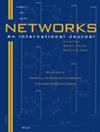通过第三方网络,以最小的成本为电信网络提供最大的连接弹性
IF 1.3
4区 计算机科学
Q4 COMPUTER SCIENCE, HARDWARE & ARCHITECTURE
引用次数: 0
摘要
在电信网络中,对多链路故障的完全连接弹性需要具有过多冗余链路的网络拓扑结构,因此成本过高。另外,电信网络的连接弹性可以通过求助于可用的第三方网络来临时增加连接,直到故障链路恢复。在这种方法中,当发生多链路故障事件时,必须提前选择网络中的一些节点作为第三方网络的网关节点。对于给定的网络拓扑和与每个节点相关的成本,将其转换为每个第三方网络的网关节点,目标是选择以最小成本提供最大连接弹性的网关节点。网关节点选择被定义为一个双目标优化问题,其帕累托最优解决方案代表了成本和连接弹性之间的不同权衡。在这项工作中,连接弹性是由关键链路检测优化问题建模的。提出了一种基于行生成算法和集合覆盖切割的精确优化算法。计算结果证明了该算法在四种已知的电信网络拓扑结构上的有效性。本文章由计算机程序翻译,如有差异,请以英文原文为准。
Provision of maximum connectivity resiliency with minimum cost to telecommunication networks through third‐party networks
In telecommunication networks, full connectivity resilience to multiple link failures is too costly as it requires a network topology with too many redundant links. Alternatively, the connectivity resilience of a telecommunications network can be improved by resorting to available third‐party networks for temporary additional connectivity until the failing links are restored. In this approach, some nodes of the network must be selected in advance to act as gateway nodes to the third‐party networks when a multiple link failure event occurs. For a given network topology and a cost associated with each node to turn it into a gateway node to each of the third‐party networks, the aim is to select the gateway nodes providing maximum connectivity resilience at minimum cost. The Gateway Node Selection is defined as a bi‐objective optimization problem such that its Pareto‐optimal solutions represent different trade‐offs between cost and connectivity resilience. In this work, the connectivity resilience is modeled by the Critical Link Detection optimization problem. An exact optimization algorithm is proposed, based on a row generation algorithm and on set cover cuts. The computational results demonstrate the effectiveness of the proposed algorithm on four well‐known telecommunication network topologies.
求助全文
通过发布文献求助,成功后即可免费获取论文全文。
去求助
来源期刊

Networks
工程技术-计算机:硬件
CiteScore
4.40
自引率
9.50%
发文量
46
审稿时长
12 months
期刊介绍:
Network problems are pervasive in our modern technological society, as witnessed by our reliance on physical networks that provide power, communication, and transportation. As well, a number of processes can be modeled using logical networks, as in the scheduling of interdependent tasks, the dating of archaeological artifacts, or the compilation of subroutines comprising a large computer program. Networks provide a common framework for posing and studying problems that often have wider applicability than their originating context.
The goal of this journal is to provide a central forum for the distribution of timely information about network problems, their design and mathematical analysis, as well as efficient algorithms for carrying out optimization on networks. The nonstandard modeling of diverse processes using networks and network concepts is also of interest. Consequently, the disciplines that are useful in studying networks are varied, including applied mathematics, operations research, computer science, discrete mathematics, and economics.
Networks publishes material on the analytic modeling of problems using networks, the mathematical analysis of network problems, the design of computationally efficient network algorithms, and innovative case studies of successful network applications. We do not typically publish works that fall in the realm of pure graph theory (without significant algorithmic and modeling contributions) or papers that deal with engineering aspects of network design. Since the audience for this journal is then necessarily broad, articles that impact multiple application areas or that creatively use new or existing methodologies are especially appropriate. We seek to publish original, well-written research papers that make a substantive contribution to the knowledge base. In addition, tutorial and survey articles are welcomed. All manuscripts are carefully refereed.
 求助内容:
求助内容: 应助结果提醒方式:
应助结果提醒方式:


